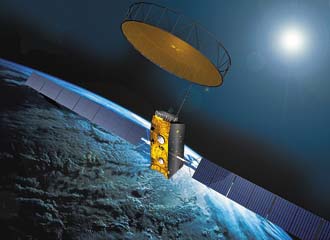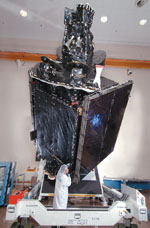High-Flying Challenges
Representatives from the companies that build and operate satellites are concerned that the Future COMSATCOM Services Acquisition (FCSA) program could threaten warfighters’ ability to connect when and where they need to in current operations. Estimates are that commercial satellites such as the Intelsat 702 (b), XTAR-EUR (m) and Inmarsat-4 provide at least 80 percent of the communications capabilities in Iraq and Afghanistan.
Changes in commercial satellite communications acquisition cause concern. 


A brand new way of doing business and a contract estimated to be worth more than $5 billion over 10 years is bound to cause some discussion. And that is exactly what is happening in vociferous debate and hushed tones between government agencies and the companies that supply the satellite communications lifeline to today’s warfighters. At issue is the wisdom of moving from buying time on commercial satellites from a limited number of providers to the ability to purchase megabits per month the same way agencies buy office supplies.
The genesis of this new line of reasoning began in 2008. The Defense Information Systems Agency (DISA),
In February, DISA and the GSA revealed the government’s revised official procurement solicitation site, FedBizOpps. The Federal Supply Schedule 70 now includes two new Special Item Numbers (SINs) for satellite communications, one for transponder capacity (SIN 132-54) and the other for subscription services (SIN 132-55). The FCSA also will address custom end-to-end solutions; however, the organizations have not yet reached an agreement on this section of the program.
The decision to revise the way COMSATCOMs are purchased has caused some consternation in that industry. The companies that have been the primary providers of satellite communications under contracts that are scheduled to end within the next three years see some opportunities on the horizon; however, they have several concerns.
For its part, DISA’s senior management refuses “to have a duel in the media with SATCOM providers” about the topic, the public affairs office says. However, Bruce Bennett, program executive officer, SATCOM, Teleport and Services, DISA, is willing to say that the military’s senior leadership, including members of the Joint Chiefs of Staff, are pleased and excited about expanding the number of vendors that can provide SATCOM products and services through the FCSA. While cognizant of the challenges and problems ahead, he believes that ultimately the program will benefit the warfighter.
William Schmidt, vice president, government services, XTAR LLC, Rockville, Maryland, believes that the FCSA brings with it both good and bad news. On the glass-is-half-full side, the government will be able to go directly to the vendor to obtain the services it needs. For vendors, the program offers the opportunity to do what they do best. “We will work with other partners to get the job done,” Schmidt says.
On the glass-is-half-empty side, however, the number of companies that can bid on proposals is somewhat unlimited. While he is not opposed to increased competition to both improve products and lower costs, Schmidt believes the FCSA approach will lead to too many companies leaping into the COMSATCOM business arena. As a result, the government will have a multitude of proposals to review, a task it may not be ready to tackle, and the limited amount of business could dash the return on investment for newcomers to the field.
From the government’s perspective, Schmidt raises the issue of time to service. “You now have two organizations—and administratively how are they going to accommodate both of their respective markets—DISA with the Defense Department and the GSA with civilian agencies? We see the potential for some administrative difficulties in managing and issuing task orders and then consequently managing contracts once they are out,” he notes.
From a carrier standpoint, there may be some issues with the transponded services. Initially, the discussion focused on limiting these only to the companies that own satellites; this is no longer the case. As a result of the FCSA, any company can make arrangements with a carrier and then offer the transponded service to the government.
“That has the potential to confuse the market as well, where you have carriers offering transponded service that they may or may not control. There may be those [companies] that get into the market without a real understanding of the market. They could unwillingly or unknowingly bid a program they are not familiar with, receive a contract, and then not be able to perform on it,” Schmidt relates. “Without other qualifications, there are other risks that could crop up.”
Despite the pros and cons, Schmidt believes that overall the FCSA is good for government and industry. For example, it addresses a number of issues that industry has had with the Defense Information Systems Network (DISN) Satellite Transmission Service-Global (DSTS-G). Like all contracts, the FCSA will go through a “teething process” as well and will improve over time. In addition, the best companies will rise to the top, he maintains.
But Schmidt does not give the government a pass on holding up its end of the deal. He says it is time for the U.S. Defense Department to better define its future COMSATCOM requirements so that companies have adequate time to plan. Companies must determine the number of satellites to build; their necessary design communications capabilities; and how to sell time on these about-to-be-launched satellites to organizations, including those in the private sector. This last item is particularly important because current estimates are that the military relies on COMSATCOM for at least 80 percent of its communications in current operations, a number some say is as high as 96 percent.
“The Defense Department, because of funding restrictions or contract restrictions or a desire by some to do everything on military satellites, is reluctant to communicate its future requirements to industry or to put its requirements in the Five-Year Defense Plan. The end result is, right now, the Defense Department and to a lesser degree the civil agencies get whatever capacity is left over in the sense that [commercial] companies don’t operate based on need. Many of those customers—whether it’s CNN, Bank of America or other large users—will come into a pre-launch commitment. What happens—in fact it has already happened—is that when the government or the Defense Department says that it needs a certain amount of capacity over Iraq or Afghanistan, it’s just not going to happen, because it wasn’t forecast. The satellites are full. The typical commercial users have done long-term if not to-end-of-life leases even before the satellites were launched. And I think it’s only going to get worse,” he says.
The facts support this opinion. Currently, between 40 percent and 60 percent of a satellite’s transponded capacity for fixed satellite services is pre-sold; by the time it is built, this amount increases to between 60 percent and 80 percent or even higher. For mobile satellite services, the model is different: It does not assume pre-sold capacity at the starting point, and unlike fixed satellites, they offer worldwide capability rather than just beams in specific populated areas.
Some Defense Department representatives argue that the number of satellites in orbit today or scheduled to be launched at a later time will be enough to meet future needs. But Schmidt points out that there is little or no capacity on the satellites that will be available in the future. “So we’re trying to encourage the government to forecast its needs so we can go to our investors and get what we need to build to meet the requirements of the future. FCSA doesn’t address this,” he adds.
Rebecca Cowen-Hirsch, president, Inmarsat Government Services Incorporated,
Cowen-Hirsch agrees that one element that is desperately needed in the FCSA program is an open line of communications between commercial satellite companies and government agencies. “One thing that is very interesting is the manner in which the Defense Department is getting ready to contract work operators and distribution operators through the FCSA. We of course want to be engaged in every single element of those [opportunities] through our distribution channels, because this is the way that satellite distribution services and capabilities will be provided to the warfighter,” she says.
“Our experience in SATCOM II has been that this approach tends to commoditize critical capability. While price is extremely important, and we recognize that in today’s economic environment it’s even more important, the operators or warfighters in special operations units may actually get what they pay for, which will be at the best price as opposed to the best service,” Cowen-Hirsch states. “As I look at the Schedule 70, it’s difficult for me to understand how it is that you can provide core mission-critical capabilities via satellite—particularly something that’s as mission-essential as communications—in the same way as you acquire office supplies.” It is difficult to understand how the end users—be it ones from telemedicine or command and control—will obtain the value-added mission-critical services they require at a proper value proposition with the requisite security, she adds, even though she is a strong advocate of competition.
Because about 80 percent or more of the Defense Department’s communications is being provided over COMSATCOMs satellites, and because the FCSA opens the field to any company that believes it can support this service, the program appears unwieldy to Cowen-Hirsch. Her question is: Can the operators’ requirements be fulfilled in an agile fashion with a meaningful distinction between the Schedule 70 providers? “That is not clear to me yet,” she states.
But the issues of the pros and the cons and price versus reliability are only a few of the issues that industry believes must be resolved before the FCSA can work the way DISA intends. Skot Butler, director of strategic initiatives, Intelsat General Corporation,
Bennett’s figures bear out the costliness of last-minute decision making for COMSATCOM purchases. Currently, Global Information Grid bandwidth costs $2,850 per megabit per month when commercial and military satellite costs are averaged. Terrestrial communications cost only $640 per megabit per month; however, the advantages of satellite communications are clear: It makes the connection where no physical connectivity is possible or infrastructure is immature.
Bennett is aware of industry’s concerns about outlining requirements and dedicating funding, and he takes them seriously. The problem is that DISA is required to work within a legal framework that is decades old. The agency cannot commit funds to any project for more than a year at a time, so until the policies change, DISA’s hands are tied. The agency is working on this issue, he says.
He also is well aware of the questions about future funding, but says COMSATCOM funding has never been the issue; $500 million worth of business has occurred. That said, he does admit that while the funding is fixed in the fiscal year 2012 Program Objective Memorandum, funding for fiscal year 2011 is debatable. This is another problem that DISA is tackling, Bennett says.
Current COMSATCOM contracts will expire in the 2012 to 2013 time frame. DISA’s goal is to make the transition to the FCSA program as seamless as possible by ensuring the processes and policies are in place as previous contracts expire, Bennett says.
WEB RESOURCES
Future COMSATCOM Services Acquisition: http://bit.ly/cQo7FH
Inmarsat Government Services Incorporated: www.inmarsat.com
Intelsat General Corporation: www.intelsat.com
XTAR LLC: www.xtarllc.com



